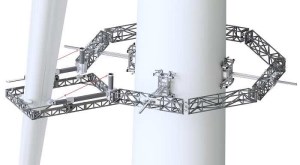A lightweight robot capable of carrying out an X-ray maintenance survey of wind turbines – offshore and onshore – is being developed for the renewable energy sector.
The RADBLAD technology from Forth Engineering in the UK, can complete a full X-ray survey of a Vesta 47 size turbine and all its blades in just a few hours.
There are currently about 350,000 wind turbines in the world. China, US, Germany, India, Spain and the UK are the top six countries in the world in terms of wind capacity.
Forth Engineering is working with a consortium of industrial and academic partners including Innvotek, TWI, ORE Catapult, Renewable Advice and London South Bank University to develop the RADBLAD technology.
The businesses and organisations involved have a wide range of expertise in robotic development and manufacture, radiography development, and AI algorithm software development.
The innovation is in line with the UK government’s policy of increasing renewable power to bring all greenhouse gas emissions to net zero by 2050.
The research follows the significant growth in installed wind power capacity globally within the last decade.
Because of the growth, a higher level of maintenance is now required across the industry with more wind turbines and more blades needing checking for faults.
At present, such surveys are carried out manually by maintenance engineers climbing the wind turbine and its blades with rope access.
Significant financial cost
About 3,800 blade failures a year are attributed to poor maintenance. There’s also a significant financial cost to such manual inspections.
To provide a solution, Forth and its partners are more than half-way through a two-year project, funded by Innovate UK, to develop its RADBLAD technology.
![Mark Telford MD Forth (1)[2] Mark Telford MD Forth (1)[2]](/Images/600/0/45617_Large.jpg)
RADBLAD’s point of difference, when compared with other systems, is in the use of radiographic based in-situ inspection, which automatically detects defects using an artificial intelligent (AI) based software.
Reducing risk of accidents and injury
The advantages of this system are early detection of blade (internal) defects, in a quicker, safer and systematic way, while reducing the risk to human operators.
The technology has already been attracting interest from robotics and AI experts around the world and is set to be ready for testing in a representative environment in April 2021 at the Offshore Renewable Energy (ORE) Catapult’s National Renewable Energy Centre in Blyth in Northumberland ready to deliver the solution later in 2021.
Forth’s program manager, Peter Routledge says RADBLAD is a world-first magnetically-adhering, wall-climbing robot, with a manipulator arm which deploys an x-ray system around a blade.
“An end effector holds the source and detector against the blade, so they move with the blade in the presence of 3-D blade vibrations,” he explains.
Reduction in downtime
![Peter Routledge (1)[2] Peter Routledge (1)[2]](/Images/600/0/45618_Large.jpg)
Peter Routledge - Program Manager, Forth
“Unlike ground radiography inspection, RADBLAD does not require costly, time-consuming onshore dismantling of blades and transportation to workshop, inspection in X-ray bays and return and reassembly, which can take around 10 days during which time revenue is lost due to generating downtime.”
Mr Routledge says the project represents a clear technological innovation for the UK offshore wind generation industry, and a major growth opportunity for the SME supply chain consortium.
“It has the potential to make significant cost and efficiency savings, with strong prospects in terms of exporting this technology around the world.”
Forth Engineering (Cumbria) Ltd is an award-winning UK advanced technology solutions business with bases at Maryport and Barrow-in-Furness in Cumbria.


